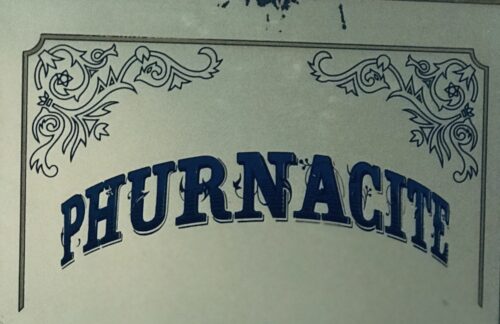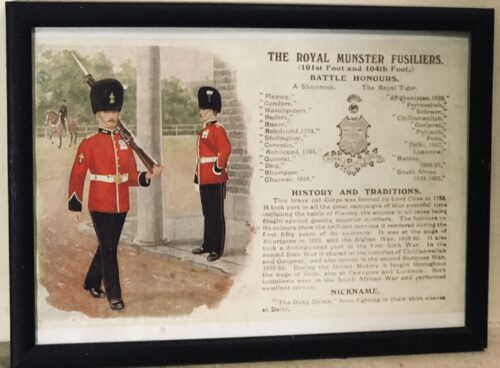67cm x 56cm
Reginald John “Rex” Whistler (24 June 1905 – 18 July 1944) was a British painter, designer and illustrator, who was killed in action in the Second World War.
Reginald John Whistler was born in Britain on 24 June 1905, in Eltham, Kent (now part of the Royal Borough of Greenwich), the son of architect and estate agent Henry Whistler and Helen Frances Mary, the daughter of Rev. Charles Slegg Ward, vicar of Wootton St Lawrence, and through her mother a descendant of the goldsmith and silversmith Paul Storr.
Cover of the Christmas 1931 edition of Radio Times
His most noted work during the early part of his career was for the café at the Tate Gallery,[3] completed in 1927 when he was only 22. He was commissioned to produce posters and illustrations for Shell Petroleum and the Radio Times. He also created designs for Wedgwood china based on drawings he made of the Devon village of Clovelly, and costumes “after Hogarth” for the premiere production of William Walton‘s ballet The Wise Virgins, produced by the Sadler’s Wells Company in 1940.
Whistler’s elegance and wit ensured his success as a portrait artist among the fashionable; he painted many members of London society, including Edith Sitwell, Cecil Beaton and other members of the set to which he belonged that became known as the “Bright Young Things”.His murals for Edwina Mountbatten‘s 30-room luxury flat in Brook House, Park Lane, London were later installed by the Mountbattens’ son-in-law, decorator David Hicks, in his own houses.
Second World War
When war broke out, although he was 35, Whistler was eager to join the army. He was commissioned into the Welsh Guards as a Second lieutenant in June 1940.He served in the Guards Armoured Division.
During the war he was the burial officer of his regiment, and his soldiers became somewhat suspicious of the 20 crosses he carried on his tank. He decided that just because he was at war it did not mean he could not paint, and he therefore also carried a bucket hanging off the side of his tank for his paintbrushes.
Death
Whistler is said to have predicted his own death. Just days before he was killed, he remarked to a friend that he wanted to be buried where he fell, not in a military cemetery. On the night before his death, a fellow officer named Francis Portal came up to him, and they talked for a while. Before they parted, Portal remarked, “So we’ll probably see each other tomorrow evening.” Wistfully, Whistler replied, “I hope so.”He was killed on 18 July 1944, after he left his tank to go to the aid of other men in his unit, killed by a mortar bomb.His body now lies in Section III, Row F, Grave 22 of Banneville-la-Campagne War Cemetery, situated 10 kilometres east of Caen.Reportedly, The Times newspaper received more letters about Whistler’s death than for any other war victim.
John Jameson was originally a lawyer from Alloa in Scotland before he founded his eponymous distillery in Dublin in 1780.Prevoius to this he had made the wise move of marrying Margaret Haig (1753–1815) in 1768,one of the simple reasons being Margaret was the eldest daughter of John Haig, the famous whisky distiller in Scotland. John and Margaret had eight sons and eight daughters, a family of 16 children. Portraits of the couple by Sir Henry Raeburn are on display in the National Gallery of Ireland.
John Jameson joined the Convivial Lodge No. 202, of the Dublin Freemasons on the 24th June 1774 and in 1780, Irish whiskey distillation began at Bow Street. In 1805, he was joined by his son John Jameson II who took over the family business that year and for the next 41 years, John Jameson II built up the business before handing over to his son John Jameson the 3rd in 1851. In 1901, the Company was formally incorporated as John Jameson and Son Ltd.
Four of John Jameson’s sons followed his footsteps in distilling in Ireland, John Jameson II (1773 – 1851) at Bow Street, William and James Jameson at Marrowbone Lane in Dublin (where they partnered their Stein relations, calling their business Jameson and Stein, before settling on William Jameson & Co.). The fourth of Jameson’s sons, Andrew, who had a small distillery at Enniscorthy, Co. Wexford, was the grandfather of Guglielmo Marconi, inventor of wireless telegraphy. Marconi’s mother was Annie Jameson, Andrew’s daughter.
John Jameson’s eldest son, Robert took over his father’s legal business in Alloa. The Jamesons became the most important distilling family in Ireland, despite rivalry between the Bow Street and Marrowbone Lane distilleries.
By the turn of the 19th century, it was the second largest producer in Ireland and one of the largest in the world, producing 1,000,000 gallons annually. Dublin at the time was the centre of world whiskey production. It was the second most popular spirit in the world after rum and internationally Jameson had by 1805 become the world’s number one whiskey. Today, Jameson is the world’s third largest single-distillery whiskey.
Historical events, for a time, set the company back. The temperance movement in Ireland had an enormous impact domestically but the two key events that affected Jameson were the Irish War of Independence and subsequent trade war with the British which denied Jameson the export markets of the Commonwealth, and shortly thereafter, the introduction of prohibition in the United States. While Scottish brands could easily slip across the Canada–US border, Jameson was excluded from its biggest market for many years.
The introduction of column stills by the Scottish blenders in the mid-19th-century enabled increased production that the Irish, still making labour-intensive single pot still whiskey, could not compete with. There was a legal enquiry somewhere in 1908 to deal with the trade definition of whiskey. The Scottish producers won within some jurisdictions, and blends became recognised in the law of that jurisdiction as whiskey. The Irish in general, and Jameson in particular, continued with the traditional pot still production process for many years.In 1966 John Jameson merged with Cork Distillers and John Powers to form the Irish Distillers Group. In 1976, the Dublin whiskey distilleries of Jameson in Bow Street and in John’s Lane were closed following the opening of a New Midleton Distillery by Irish Distillers outside Cork. The Midleton Distillery now produces much of the Irish whiskey sold in Ireland under the Jameson, Midleton, Powers, Redbreast, Spot and Paddy labels. The new facility adjoins the Old Midleton Distillery, the original home of the Paddy label, which is now home to the Jameson Experience Visitor Centre and the Irish Whiskey Academy. The Jameson brand was acquired by the French drinks conglomerate Pernod Ricard in 1988, when it bought Irish Distillers. The old Jameson Distillery in Bow Street near Smithfield in Dublin now serves as a museum which offers tours and tastings. The distillery, which is historical in nature and no longer produces whiskey on site, went through a $12.6 million renovation that was concluded in March 2016, and is now a focal part of Ireland’s strategy to raise the number of whiskey tourists, which stood at 600,000 in 2017.Bow Street also now has a fully functioning Maturation Warehouse within its walls since the 2016 renovation. It is here that Jameson 18 Bow Street is finished before being bottled at Cask Strength.
In 2008, The Local, an Irish pub in Minneapolis, sold 671 cases of Jameson (22 bottles a day),making it the largest server of Jameson’s in the world – a title it
















